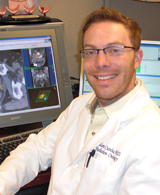Program Information
Novel Custom Nasopharynx Applicator with Variable-Density Shielding to Reduce Normal Structure Dose and Allow Target Dose Escalation: Design, Fabrication, and Dosimetry
J A Cunha1*, S McKinley2 , J Phillips1 , Y Ma3 , L Beaulieu3 , I Hsu1 , K Goldberg1,2 , (1) UC San Francisco, San Francisco, CA, (2) University of California, Berkeley, Berkeley, CA, (3) Centre hospitalier Universitaire de Quebec, Quebec, QC
Presentations
WE-AB-605-11 (Wednesday, August 2, 2017) 7:30 AM - 9:30 AM Room: 605
Purpose: Brachytherapy can be an effective treatment for early stage nasopharyngeal cancer. But applicators available for high dose rate brachytherapy of the nasopharynx are a simple design that rely only on the inverse-r-squared falloff to protect the normal tissue of the soft palate. Soft palate toxicity limits the dose that can be delivered to the nasopharynx, often leading to sub-optimal coverage of the clinical target volume (CTV). We present a new applicator that incorporates custom shielding, evaluate its effectiveness, and parameterize the shielding necessary to produce various dosimetric effects.
Methods: Custom applicators were fabricated from USP Class VI biocompatible platinum cure silicone rubber and tungsten shielding. Two different shielding options were employed: solid tungsten and 3D-printed tungsten. Average density of the 3D-printed tungsten was 4.0 g/cc, that of solid tungsten is 19.25 g/cc. Monte Carlo models of the applicators were generated. Film dosimetry was performed using GafChromic EBT2 film to validate the Monte Carlo code. Dosimetric comparisons were made using reference CT image sets of patients previously treated with brachytherapy in our clinic.
Results: Analysis shows that incorporating 3 mm solid tungsten shielding into the applicator allowed for a 58% reduction in dose at the applicator-soft palate interface for the solid tungsten block. A 14% reduction was measured for the 4.0 g/cc 3D-printed tungsten.
Conclusion: Incorporating shielding into a nasopharynx brachytherapy applicator can significantly reduce the dose to the soft palate. This would allow the either dose escalation in the CTV and/or increased target coverage of the prescription dose with reduced risk to the nearby normal tissue. Custom fabrication using additive manufacturing with tungsten allows a range of shielding densities that can be customized to the needs of each patient. This can significantly reduce toxicity for these patients.
Contact Email:
